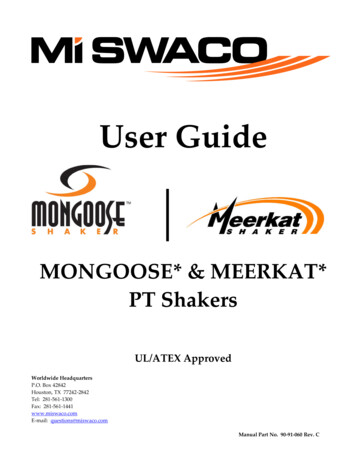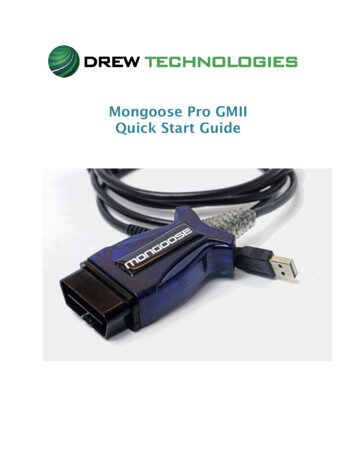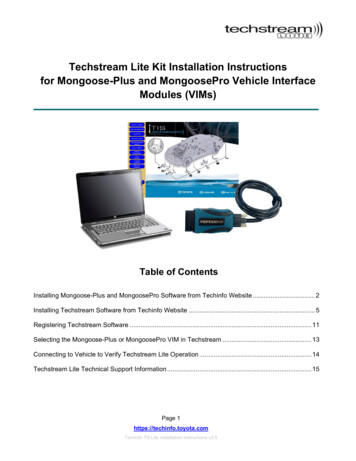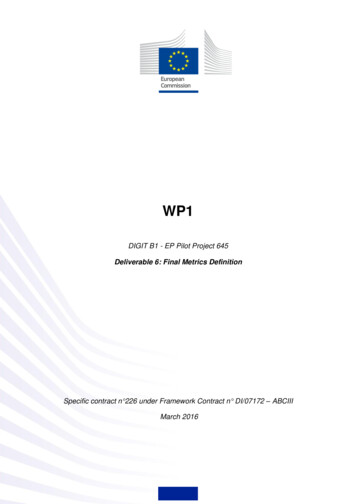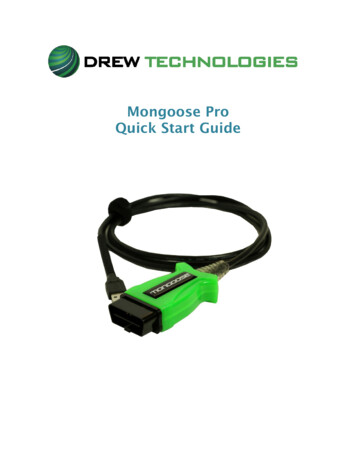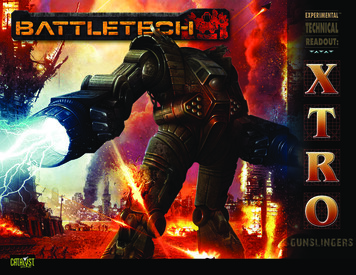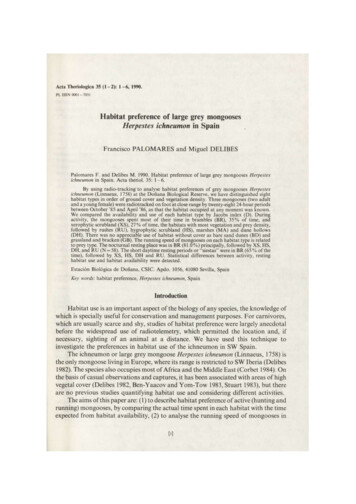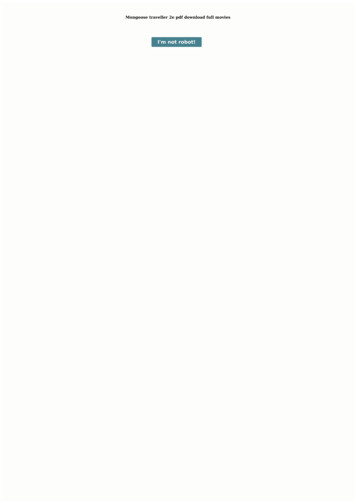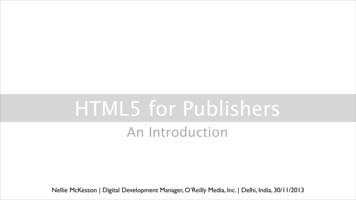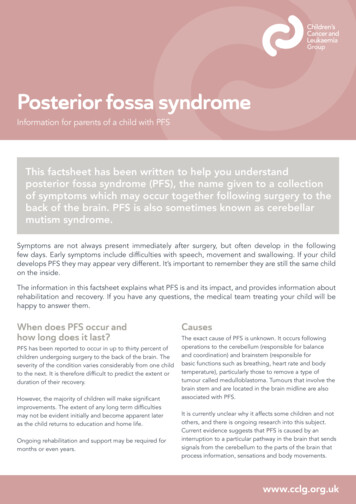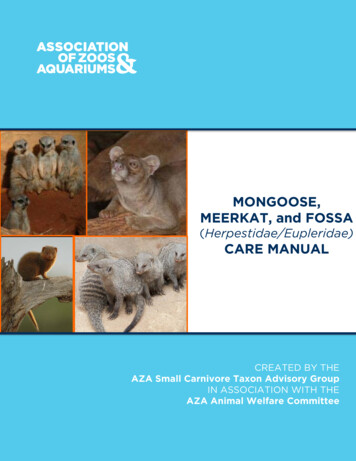
Transcription
MONGOOSE,MEERKAT, and FOSSA(Herpestidae/Eupleridae)CARE MANUALCREATED BY THEAZA Small Carnivore Taxon Advisory GroupIN ASSOCIATION WITH THEAZA Animal Welfare Committee
Mongoose, Meerkat, and Fossa (Herpestidae/Eupleridae) Care ManualMongoose, Meerkat, & Fossa (Herpestidae/Eupleridae) Care ManualPublished by the Association of Zoos and AquariumsFormal Citation:AZA Small Carnivore TAG 2011. Mongoose, Meerkat, & Fossa (Herpestidae/Eupleridae) Care Manual.Association of Zoos and Aquariums, Silver Spring, MD. pp.103.Original Completion Date:June 2008. Revision October 2011.Authors and Significant contributors:Jan Reed-Smith, Mongoose, Meerkat, & Fossa ACM CoordinatorCeleste (Dusty) Lombardi, AZA Small Carnivore TAG Chair, Columbus Zoo and AquariumAchim Winkler, AZA Fossa Studbook Keeper, Duisberg ZooKatie Kimble, AZA Meerkat Studbook Keeper, Toledo ZooMike Maslanka, MSc, Nutrition Advisor, Smithsonian Institution’s National Zoological ParkChristine McKnight, AZA Dwarf Mongoose Studbook Keeper, Minnesota Zoological GardenBarbara Henry, MSc, Nutrition Advisor, Cincinnati Zoo & Botanical GardenAnneke Moresco, DVM, PhD, Veterinary AdvisorMaryann Weiss, St. Louis ZooSee Appendix J for a complete list of contributors and contact information.Reviewers:Thanks go to all internal reviewers (AZA Small Carnivore TAG members, AZA Animal Health Committee;AZA Nutrition Advisory Group; Don Moore, Katie Kimble, Mike Dulaney, Joseph Barber, ChristineMcKnight, Donna Ialeggio, Ellen Dierenfeld) and the members of the Association of Zoos and Aquariumsfor their time and effort in creating, reviewing, and using the Mongoose, Meerkat, and Fossa Animal CareManual.Special thanks to the external reviewers:Achim Winkler, Director Duisberg Zoo, GermanyCaroline Brown, U.K. Small Mammal TAGAZA Staff Editors:Katie Zdilla, AZA ACM InternMaya Seaman, AZA ACM InternCandice Dorsey, Ph.D., Director, Animal ConservationCover Photo Credits:Meerkat: C. H. KimbleFossa: Lee Simmons, Omaha’s Henry Doorly ZooDwarf Mongoose: Steve Barrett 2005Banded Mongoose: Fort Wayne Children’s ZooDisclaimer: This manual presents a compilation of knowledge provided by recognized animal expertsbased on the current science, practice, and technology of animal management. The manual assemblesbasic requirements, best practices, and animal care recommendations to maximize capacity forexcellence in animal care and welfare. The manual should be considered a work in progress, sincepractices continue to evolve through advances in scientific knowledge. The use of information within thismanual should be in accordance with all local, state, and federal laws and regulations concerning thecare of animals. While some government laws and regulations may be referenced in this manual, theseare not all-inclusive nor is this manual intended to serve as an evaluation tool for those agencies. Therecommendations included are not meant to be exclusive management approaches, diets, medicaltreatments, or procedures, and may require adaptation to meet the specific needs of individual animalsand particular circumstances in each institution. Commercial entities and media identified are notnecessarily endorsed by AZA. The statements presented throughout the body of the manual do notrepresent AZA standards of care unless specifically identified as such in clearly marked sidebar boxes.Association of Zoos and Aquariums2
gonline.net%%%
Mongoose, Meerkat, and Fossa (Herpestidae/Eupleridae) Care ManualChapter 5. Nutrition5.1 Nutritional RequirementsA formal nutrition program is recommended to meet the nutritionalAZA Accreditation Standardand behavioral needs of all mongooses and fossas (AZAAccreditation Standard 2.6.2). Diets should be developed using(2.6.2) A formal nutrition program isrecommended to meet the behavioral andthe recommendations of nutritionists, the Nutrition Scientificnutritional needs of all species andAdvisory Group (NAG) feeding guidelines:specimens within the delines/feeding guidelines.htm), and veterinarians as well as AZA Taxon AdvisoryGroups (TAGs), and Species Survival Plan (SSP) Programs. Diet formulation criteria should addressthe animal’s nutritional needs, feeding ecology, as well as individual and natural histories to ensure thatspecies-specific feeding patterns and behaviors are stimulated.Herpestid and euplerid species consume a range of food items including vertebrates, eggs, fish,invertebrates, and some plant/vegetable matter (Gould & McKay, 1998; Macdonald, 1999; Nowak, 1999;Ray & Sunquist, 2001). Cusimanse (Crossarchus obscurus) forage on vertebrate prey, eggs, invertebrateprey, and fruit. This species is known to break eggs utilizing their forepaws positioned back between thehind feet and a hard object (Nowak, 1999). Fossas (Cryptoprocta ferox) are highly opportunistic feederswith hyena-like dentition (L. Dollar, personal communication, 2005), and will consume almost anyvertebrates and some invertebrates they naturally encounter. Dwarf mongooses (Helogale parvula)mainly forage invertebrate prey along with small vertebrates, eggs, and fruit. Meerkats (Suricata suricatta)primarily forage invertebrate prey but also small vertebrate prey, eggs, and vegetable matter. Bandedmongooses consume small vertebrates like birds, snakes, and rats; their diet also includes invertebrates,reptile, or bird eggs, and they reportedly eat fallen fruit.Digestive System Morphology and Physiology: Dentition in these families is highly variable, reflectingfood specialization of species within the families (Schliemann, 1990). Meerkats possess dentition withwell-developed molar cusps for crushing chitinous exoskeletons, while banded mongooses have morepronounced crushing dentition as seen in carnivores (Schliemann, 1990).The gastrointestinal tract of mongoose is reported to be quite similar to that of a domestic cat;however, the cecum is very rudimentary in some and absent others (Stevens & Hume, 1995).Nutrient Requirements: Although many of the items consumed by these species are known, the nutrientcontent of these items has not been completely characterized. In many cases, target nutrient levels arebased on those of well-studied carnivores and, to a lesser extent, omnivores (e.g., Arctic fox/mink andcats). Ranges are provided to best describe the needs across a variety of genera, with the high ends ofeach range for growing and lactating animals. In most cases, they reflect the highest values reported.Based on the emphasis of foraging strategy of the genus or species in question, a range of target nutrientvalues has been provided for more omnivorous or more carnivorous individuals (Table 6). These valuesinclude cat requirements (NRC, 2006; Legrand-Defretin & Munday, 1993; AAFCO, 1994), Arctic fox/mink(NRC, 1982) requirements, and general mustelid guidelines (Maslanka et al., 1999). As additionalinformation becomes available, these ranges should be adjusted to reflect new knowledge.Meerkat: Taurine has been determined to be a necessary component to the diet of meerkats; lack oftaurine may result in enlarged hearts and related complications. Diets should contain a form of cat food(which is rich in taurine), mice (which also contain taurine), or taurine dietary supplements (K. Kimble,personal communication, 2004 & 2005). See Appendix F for nutrient descriptions and Chapter 6:Veterinary Care for additional information.Energy Requirements: Available information suggests that energy requirements are closely related tobody mass, food habits, climate, and activity level, but these factors are all interrelated and some exertmore influence than others. Invertebrate-eating specialists in Herpestidae have low basal metabolic ratesprimarily due to their eating habits (McNab, 1989). Work done by Muñoz-Garcia & Williams (2005) on thebasal metabolic rate (BMR) of 58 Carnivora species indicated, after controlling for body mass, a strongcorrelation between home range size (used as a proxy for level of activity), diet, and BMR. Based uponthis work Muñoz-Garcia and Williams (2005) concluded, “ species that eat meat have larger homeranges and higher BMR than species that eat vegetable matter.”Association of Zoos and Aquariums27
Mongoose, Meerkat, and Fossa (Herpestidae/Eupleridae) Care ManualTable 5: Basal Metabolic Rate (BMR) of Selected Herpestidae and Eupleridae Species (from: Muñoz-Garcia &Williams, 2005; citing original sources)SpeciesHerpestes sanguineusHerpestes auropunctatusSuricata suricattaFossa fossaBody Mass(g)BMR (kJ/d)Diet (%)Meat/Invert/VegHome Range2(km )*5406118502,260194.4193.56 149148.92 ot listedNot listedNot listedNot listed* Females onlyThe target nutrient values in these standard recommendations encompass the needs formaintenance of adults, reproducing animals (gestation and lactation), as well as needs for growinganimals. The sample diets included herein have supported all life stages. Goal weights for individualsshould be established, and body weight checked frequently, so that diet adjustments can be made in atimely fashion to avoid over or under-condition.Table 6: Target nutrient ranges for baseline species (dry matter basis)1NutrientMore CarnivorousFossa, Meerkat, Dwarf Mongoose, Banded MongooseProtein (%)19.7–32.5Fat (%)9.0–30Linoleic Acid (%)0.5–0.55Vitamin A (IU/g)2.44–10Vitamin D (IU/g)0.25–1.0Vitamin E (mg/kg)27–120Thiamin (mg/kg)1.0–5.6Riboflavin (mg/kg)1.6–4.25Pantothenic acid (mg/kg)5.0–8.0Niacin (mg/kg)9.6–60Pyridoxine (mg/kg)1.6–4.0Folacin (mg/kg)0.2–1.3Biotin (mg/kg)0.07–0.12Vitamin B12 (mg/kg)0.02–0.0352aCalcium (%)0.29–1.02aPhosphorus (%)0.26–0.8Potassium (%)0.4–0.6Sodium (%)0.05–0.4Magnesium (%)Iron (mg/kg)Zinc (mg/kg)Copper (mg/kg)Iodine (mg/kg)Selenium .20.1–0.41Cat NRC (2006), Legrand-Defretin & Munday (1993), Cat AAFCO (1994); Maslanka et al. (1999); Mink NRC (1982); Fox NRC(1982) (for mink and fox NRC protein is range of growth and maintenance, vitamins are for growth, and minerals for growth andmaintenance).2aAuthors of this chapter would caution feeding diets with 0.29% calcium and 0.26% phosphorus as the Cat NRC 2006 suggests.Increased or decreased requirements for illness, thermoregulation, or activity can be met by offeringdiets ad libitum and monitoring body weight and condition over time. In general, diets should be offeredso that a small amount of food is remaining at the end of the feeding period. However, each animalshould be managed on an individual basis to avoid obesity. Group dynamics often play a role in theAssociation of Zoos and Aquariums28
Mongoose, Meerkat, and Fossa (Herpestidae/Eupleridae) Care Manualnutrient content of the consumed diet, with animals consuming more or less energy, comparatively, basedon their status in the dominance hierarchy.Nutrition for alternate life stages/conditions: In general, diets should be formulated with the individualanimal in mind, even for animals housed in groups. Diet adjustments should be based on condition of theanimal in question, and can be applied for a variety of reasons — growth and development, gestation orlactation status, activity level, illness, and/or seasonal changes.Age: Feeding should be observed to insure the subordinate animals receive the correct proportions ofingredients. Often increasing the number of feeding times per day, placing the food in several locations(particularly for meerkat and mongoose species), distracting some of the animals to allow othersadequate access or visually separating animals are necessary in a group of animals.Reproductive status: Total food quantity may need to be increased during pregnancy and lactation tomaintain female body weight appropriately. Some weight loss may be appropriate (adipose mobilizationto support lactation), but should be monitored regularly to ensure health of the female. In some casescalcium intake may also need to increase.It is important to note that in dwarf mongoose, females typically produce multiple litters in successionso that they can be both pregnant and lactating at the same time. Producing up to four litters in 6 months,each averaging 22% of the female’s body mass, has substantial energy requirements (Creel, 1996). As aresult the female will likely need increased food quantity for successful reproduction and rearing of theyoung, particularly if the group size is small (C. McKnight, personal communication, 2010).5.2 DietsThe formulation, preparation, and delivery of all diets must beAZA Accreditation Standardof a quality and quantity suitable to meet the animal’s(2.6.3)Animal diets must be of a qualitypsychological and behavioral needs (AZA Accreditation Standardand quantity suitable for each animal’s2.6.3). Food should be purchased from reliable, sustainable, andnutritional and psychological needs. Dietwell-managed sources. The nutritional analysis of the food shouldformulations and records of analysis ofappropriate feed items should bebe regularly tested and recorded.maintained and may be examined by theThere is a wide range of diets that may be available toVisiting Committee. Animal food,Euplerids and Herpestids (sample diets listed in Table 7). Asespecially seafood products, should beomnivores and carnivores, diets that contain a mix of food itemspurchased from reliable sources that aresustainable and/or well managed.and groups appear most appropriate, with emphasis on vertebrateand invertebrate portions of the diet for more carnivorous members(e.g., fossa, meerkat, banded and dwarf mongoose). Ideally, a palatable, nutritionally complete food (wetor dry) may be used as the base of the diet to which other items are added as appropriate based onfeeding strategy. Water should be available at all times. The nutrient profiles of these diets are listed inTable 6.Association of Zoos and Aquariums29
Mongoose, Meerkat, and Fossa (Herpestidae/Eupleridae) Care ManualTable 7: Sample diet from AZA institutions of herpestid species as fed daily*SpeciesCommonInstitution1Food ItemNameCryptoproctaFossa1Institution ANatural Balance Carnivore 5%feroxIAMS weight control cat dryMouseFemur BoneTotalInstitution BNebraska Special Beef FelineGround Meat – beef, horse, bisonRatBoneTotalInstitution CNebraska Premium BeefGround Meat - beefRatTotalSuricataMeerkatInstitution CIAMS adult cat food drysuricattaNatural Balance Carnivore 10%Fruit – used appleStarch – used sweet potatoVeggies – used carrotCricketsTotalInstitution DRoyal Canine Vet Diet Low FatFruit/Vegetable – usedapple/carrotOat cereal – CheeriosFuzzy (6 grams) (2x/wk)AvocadoInsects – used cricketsTotalInstitution EPMI Exclusive chicken dryPMI Exclusive chicken light dryFruit – used appleCarrotYamNatural Balance Carnivore 10%MiceEgg, hard-boiledTotalInstitution FTotally Ferret, groundFruit/VegetableMealwormsMouseEgg, hard-boiledGround Meat – beefCalcium carbonateTotalInstitution GIAMS less active cat dryZuPreem Feline cannedFruit – used appleRoot vegetable – sweet potatoCapelinMouseEgg, hard-boiledNatural Balance Carnivore 10%Mouse, pinkieTotalAssociation of Zoos and Aquariumsgrams/day% in 111.6929.233.343.136.681.670.4210030
Mongoose, Meerkat, and Fossa (Herpestidae/Eupleridae) Care ManualHelogaleparvulaDwarfMongooseInstitution FInstitution AInstitution BMungosmungo1BandedMongooseZoo H**Eukanuba cat maintenance drychknCricketsMealwormsYamCornPeasMice, pinkieEgg, hard-boiledTotalIAMS less active cat dryFruit – used appleRoot Vegetable – used sweetpotatoNatural Balance Carnivore 5%CricketMealwormTotalEVO Feline Diet dryZuPreem Feline cannedReliable Protein ProductInsectivoreCarrots – groundSweet Potato – groundEgg, hard-boiledMouse, ickNatural Balance Carnivore 5%Mazuri Insectivore al Balance Pet Foods, Inc. Pacoima, CA 91331; P&G Pet Care (IAMS), Cincinnati, OH 45220; Marion Zoological, Plymouth,MN 55441; Central Nebraska Packing, Inc. North Platte, NE 69103; Waltham Royal Canine USA, Inc., St. Charles, MO 63301; PMINutrition, Henderson, CO 80640; Performance Foods, INC., Broomfield, CO 80021; ZuPreem; Shawnee, KS 66214; EVO PetProducts, Santa Clara, CA 95052; Reliable Protein Products, Phoenix, AZ 85050; Mazuri PMI Nutrition International. Brentwood,MO 63144.* The AZA SCTAG does not specifically endorse the use of any mentioned products.** Also feed one medium sized mouse per individual daily.Association of Zoos and Aquariums31
Mongoose, Meerkat, and Fossa (Herpestidae/Eupleridae) Care Manual1Table 8: Nutrient content of sample diets (dry matter basis)InstitutionInstitution AInstitution BInstitution CNutrientProtein (%)Fat (%)Vitamin A (IU/g)Vitamin D (IU/g)Vitamin E (mg/kg)Thiamin (mg/kg)Riboflavin (mg/kg)Pantothenic acid(mg/kg)Niacin (mg/kg)Pyridoxine (mg/kg)Folacin (mg/kg)Biotin (mg/kg)Vitamin B12 (mg/kg)Calcium (%)Phosphorus (%)Potassium (%)Sodium (%)Magnesium (%)Iron (mg/kg)Zinc (mg/kg)Copper (mg/kg)Iodine (mg/kg)Selenium (mg/kg)NutrientProtein (%)Fat (%)Vitamin A (IU/g)Vitamin D (IU/g)Vitamin E (mg/kg)Thiamin (mg/kg)Riboflavin (mg/kg)Pantothenic acid(mg/kg)Niacin (mg/kg)Pyridoxine (mg/kg)Folacin (mg/kg)Biotin (mg/kg)Vitamin B12 (mg/kg)Calcium (%)Phosphorus (%)Potassium (%)Sodium (%)Magnesium (%)Iron (mg/kg)Zinc (mg/kg)Copper (mg/kg)Iodine (mg/kg)Selenium 99.70.420.49Institution CInstitution 0.1–0.422Institution EInstitution ation of Zoos and Aquariums32
Mongoose, Meerkat, and Fossa (Herpestidae/Eupleridae) Care ManualNutrientProtein (%)Fat (%)Vitamin A (IU/g)Vitamin D (IU/g)Vitamin E (mg/kg)Thiamin (mg/kg)Riboflavin (mg/kg)Pantothenic acid(mg/kg)Niacin (mg/kg)Pyridoxine (mg/kg)Folacin (mg/kg)Biotin (mg/kg)Vitamin B12 (mg/kg)Calcium (%)Phosphorus (%)Potassium (%)Sodium (%)Magnesium (%)Iron (mg/kg)Zinc (mg/kg)Copper (mg/kg)Iodine (mg/kg)Selenium (mg/kg)1NutrientProtein (%)Fat (%)Vitamin A (IU/g)Vitamin D (IU/g)Vitamin E (mg/kg)Thiamin (mg/kg)Riboflavin (mg/kg)Pantothenic acid(mg/kg)Niacin (mg/kg)Pyridoxine (mg/kg)Folacin (mg/kg)Biotin (mg/kg)Vitamin B12 (mg/kg)Calcium (%)Phosphorus (%)Potassium (%)Sodium (%)Magnesium (%)Iron (mg/kg)Zinc (mg/kg)Copper (mg/kg)Iodine (mg/kg)Selenium (mg/kg)Institution FDwfMongoose34.415.915.21.380.114.811.8Institution ADwfMongoose26.810.51422.112621.415.0Institution oo 45.0–8.80.35–2.20.1–0.4Target nutrient levels listed in Table 7.Missing values in database so nutrients most likely meet targets.2General Food and Water Recommendations: Water and feeding stations should be located off theground, in the branches or trees, for arboreal species. Water can be provided in a bowl or water bottles.All individuals should be observed to ensure that they know how to use the water bottle. Food can beAssociation of Zoos and Aquariums33
Mongoose, Meerkat, and Fossa (Herpestidae/Eupleridae) Care Manualoffered in a non-tippable container, placed to minimize the impact of dominance hierarchies, if group-fed.Enrichment items may be scattered to encourage foraging.Typically, animals should be fed in accordance with their species-typical activity pattern, i.e.,nocturnal animals fed prior to their ‘night’ (which can be reversed for exhibition purposes), and diurnalanimals fed in the morning. Some species benefit from more frequent feedings with the added bonus thatthis also can raise the activity level in an exhibit (meerkat exception below), and a minimum of twofeedings is recommended (AZA Small Carnivore TAG). An effective method is to provide the primary dietin one or two feedings and scheduled enrichment feedings that can be scattered to encourageforaging/hunting during public hours. All food enrichment should be included when energy intake for thetotal diet is determined. All feeding times should be variable to minimize anticipatory behavior andstereotypies developed at feeding/enrichment times.The provision of species appropriate enrichment items, including food, is advisable. Food items usedas enrichment should be included as part of the diet, varied in terms of content when they are offered,and presented in such a way as to encourage species-typical foraging activities (e.g., on the ground, inthe trees, hidden in holes, etc.). Live insects, fruit pieces, kibble, and frozen mice are just some of thefood items that have been used. Consider that food-based enrichment should revolve around novel waysto present the base diet, not necessarily increasing the variety of the diet as it exists.In general, it is recommended to offer the diet in several feedings over the course of the day (seebelow for meerkat exception). Offering several meals will allow for more opportunities to adequatelydistribute food items to animals within a group. A minimum of two feedings per day is recommended; thisincludes any enrichment feedings (AZA Small Carnivore TAG recommendation). Food should be offeredin containers that are cleaned and sanitized after each use. Remnants of food scattered/hidden asenrichment should be removed.Banded mongoose: Zoo H gives banded mongoose 9 grams of 3/4 inch crickets each or 9 grams ofwaxworms each. Each mongoose also gets 1 medium mouse in addition to the items listed previously.Banded mongoose are an omnivorous species. Food is always scattered around to help with aggressionand the insect part of their diet is offered in puzzle feeders which keeps them entertained for hours.Fossa: Fossas are strictly carnivorous and can be fed a variety of different food items approximating0.5–1.0 kg (1.1–2.2 lbs) per animal per day (Winkler, 2002). Fossas have generally been fed once a day,but this amount can be divided into several, smaller feedings throughout the day and hidden/scattered inthe exhibit to encourage foraging/hunting behavior; larger items such as rodents can be hung frombranches etc. (Winkler, 2002).In situ fossas will not eat carrion (L. Dollar, personal communication, 2005), so wild caught animalsmay be resistant to consuming dead food. In these cases, they will initially have to be fed live prey untilthey make the transition. However, in general, fossas should be fed a variety of whole carcass foodswhenever possible; these can include: mice, rats, day-old chicks, chicken, and meat with bone (Winkler,2002).Meerkat: In stable groups, at least one feeding station should be provided for every three individuals.In non-stable groups, or groups in which food aggression has been observed there should be at least onefeeding station for each individual in the group with feeding stations distributed in such a way that no oneindividual can monopolize more than one feeding station. Scattering diet items and/or multiple feedingstations are the most effective ways to feed a large group of meerkats. When offering enrichment items,there should be at least one item for each individual to prevent aggression, and items should be spreadout as much as possible.The primary part of the diet should be fed in the morning, allowing animals to eat throughout the day.Whole prey items (e.g., mice, ribs) and live bugs (mealworms and crickets) can be fed in theafternoon/early evening or at scattered enrichment times. Care should be taken when feeding whole preythat each individual receives an item, thereby minimizing opportunities for aggression (K. Kimble,personal communication, 2004 & 2005).Initial introduction of food can stimulate aggression amongst meerkats; therefore, it is recommendedthat they be offered the majority of their diet once daily, in the morning. If a schedule of multiple, smallfeedings is adopted the provision of less food more often may stimulate unnecessary aggression leadingto social unrest (K. Kimble, personal communication, 2004 & 2005).Association of Zoos and Aquariums34
Mongoose, Meerkat, and Fossa (Herpestidae/Eupleridae) Care ManualGenerally, meerkats will not finish all of their diet at one feeding, instead visiting feeding stationsthroughout the day. Dominant animals tend not to guard food locations for long periods of time, thusallowing subordinate individuals an opportunity to eat once more dominant individuals are satiated andtire of protecting feeding stations. Whole prey and insects may be fed later in the day to promote activityand foraging behavior. Again, when providing enrichment items it is important that enough individualitems are offered to allow foraging participation by the entire group (K. Kimble, personal communication,2004 & 2005).Food preparation must be performed in accordance with allAZA Accreditation Standardrelevant federal, state, or local regulations (AZA AccreditationStandard 2.6.1). Meat processed on site should be processed(2.6.1) Animal food preparations mustmeet all local, state/provincial, and federalfollowing all USDA standards. The appropriate hazard analysisregulations.and critical control points (HACCP) food safety protocols for thediet ingredients, diet preparation, and diet administration shouldbe established for the taxa or species specified. Diet preparationAZA Accreditation Standardstaff should remain current on food recalls, updates, and(2.6.4)The institution should assign atregulations per USDA/FDA. Remove food within a maximum ofleast one person to oversee appropriate24 hours of being offered unless state or federal regulationsbrowse material for the collection.specify otherwise and dispose of per USDA guidelines.If browse plants are used within the animal’s diet or for enrichment, all plants must be identified andassessed for safety. The responsibility for approval of plants and oversight of the program should beassigned to at least one qualified individual (AZA Accreditation Standard 2.6.4). The program shouldidentify if the plants have been treated with any chemicals or near any point sources of pollution and if theplants are safe for the mongoose and fossa. If animals have access to plants in and around their exhibits,there should be a staff member responsible for ensuring that toxic plants are not available.5.3 Nutritional EvaluationsAn animal’s weight should be monitored regularly, and the diet adjusted to maintain the individual atits optimum overall or seasonal weight. An individual’s size should be taken into consideration whenformulating a diet rather than using generic male/female body weights. Some individuals tend towardobesity, and season and activity patterns can influence consumption and subsequent body condition. Forthese reasons, “goal weights” should be established for individuals (in general or on a seasonal basis),and body weights checked frequently, so that diet adjustments can be made in a timely fashion to avoidover- or under-conditioning.Association of Zoos and Aquariums35
Mongoose, Meerkat, and Fossa (Herpestidae/Eupleridae) Care Manualgroup, it is always dangerous to separate individuals from their group due to possible re-introductionchallenges. It is important for the other group members to be able to interact with the pups and performspecies-typical behaviors such as babysitting. Furthermore, a dam that does not have other individuals tohelp with the care of the pups may not leave the pups in the den to fulfill her own basic needs such aseating and drinking.7.5 Assisted RearingAlthough mothers may successfully give birth, there are times when they are not able to properly carefor their offspring, both in the wild and in ex situ populations. Fo
The gastrointestinal tract of mongoose is reported to be quite similar to that of a domestic cat; however, the cecum is very rudimentary in some and absent others (Stevens & Hume, 1995). Nutrient Requirements: Although many of the items consumed by these species are known, the nutrient
